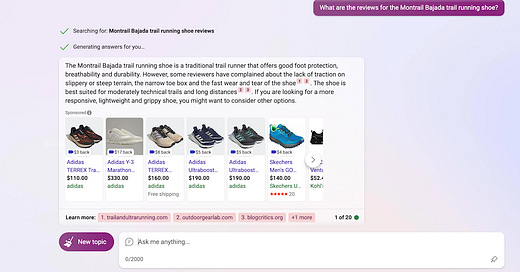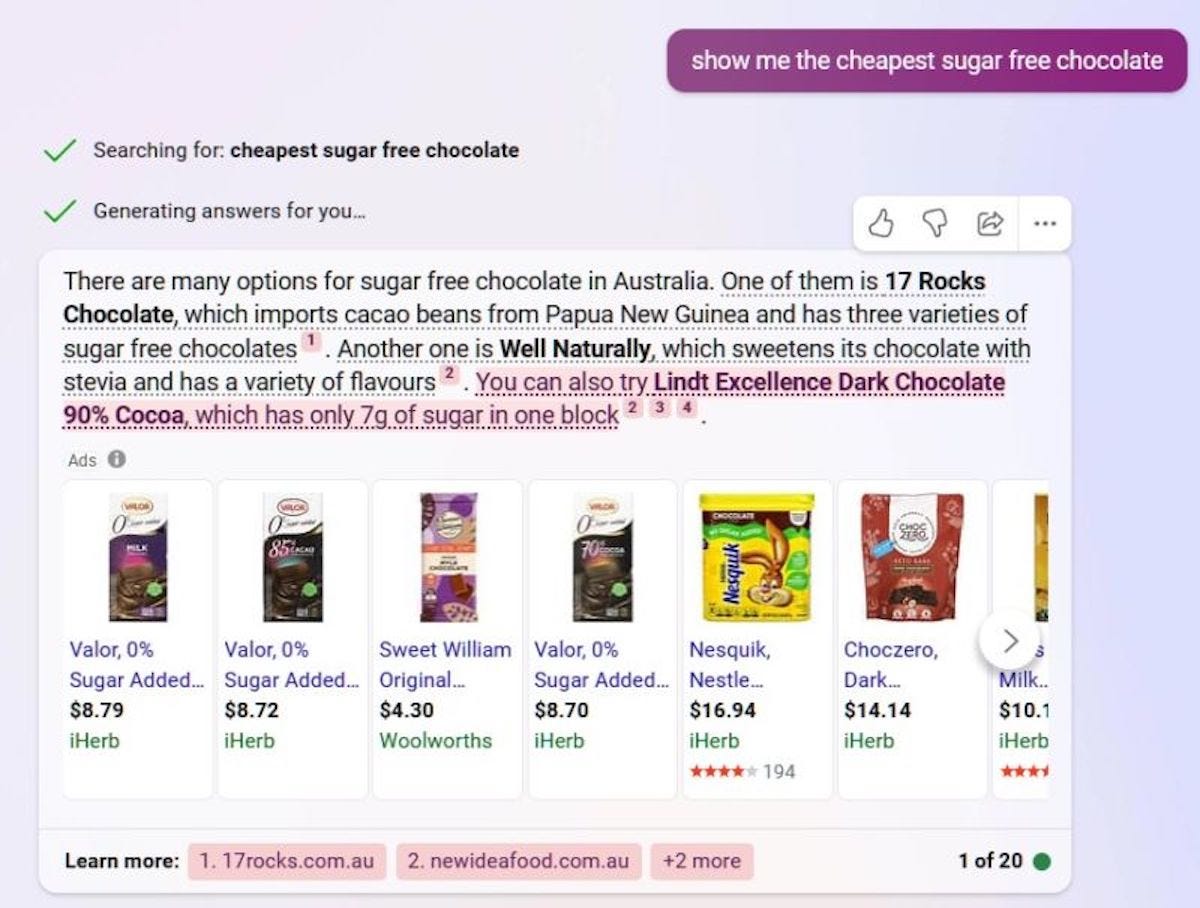New Bing Gets Ads, Hits 100M Chats for the GPT-4-Powered Search
Somebody has to pay for all those inference costs on Azure!
Microsoft’s Yusuf Mehdi warned us. The New Bing would be free and ad-supported. The format of those ads today looks a lot like what you find in traditional search, as you can see above. A carousel of running shoes shows up with prices and links to purchase pages.
These ads conveniently appear after Bing Chat’s answer about reviews and carry a “Sponsored” label above the commerce section. This information is in addition to the organic source links to the pages Bing consulted in generating the answer. Note that none of those displayed are for the shoe mentioned in the question.
Another example below is courtesy of Jurgen Gravestein. You see the same format an answer followed by an “Ads” label and an online shopping carousel, and then the source links.
Comparison with Traditional Bing Ads
The traditional Bing response (included below) shows a similar carousel of e-commerce ads before the top organic search result, which is the same source citation as the first Bing Chat result.
This strikes me as the typical process we see with all new technologies that are substitutes for existing solutions. It’s similar to skeuomorphism because it seems familiar and might be a way to ease consumers into accepting ads in the new service. This approach also enables an easy performance comparison with a mature and optimized ad product.
Granted, Mehdi told Fortune in an interview in February that he was unsure what type of ads would work best in the new search interaction model.
Microsoft believes advertising will continue to be the primary money-maker for Bing, even as it hopes to transform the search business with its new OpenAI-infused search tool. In a conversation with Fortune on Wednesday, Microsoft executive Yusuf Mehdi acknowledged that the company is still not sure what the ideal ads will look like or how the ad business model will evolve in a world where search looks more like a chatbot than a traditional search engine.
Mehdi suggested a new idea in a blog post published last week. A new hover-over experience may offer additional information for the source links in order to help publishers add more context and potentially gain more click-throughs. Licensed content may also be promoted alongside chat answers.
An expanded hover experience where hovering over a link from a publisher will display more links from that publisher giving the user more ways to engage and driving more traffic to the publisher’s website.
For our Microsoft Start partners, placing a rich caption of Microsoft Start licensed content beside the chat answer helping to drive more user engagement with the content on Microsoft Start where we share the ad revenue with the partner. We’re also exploring placing ads in the chat experience to share the ad revenue with partners whose content contributed to the chat response.
This feature that enhances visibility for publisher partners can surely be used for advertising as well. If it works well in their tests with publisher content promotion, you can be sure it will make its way into the ad sales options.
What to Expect from Bing
The core ad experience will initially be very similar to what we see on the web, with somewhat less screen real estate to work with. The carousel is fairly tall in pixels, and it looks like two horizontal ads could appear in that space as an alternative.
I have not been able to recreate this on Bing mobile, so it looks like this is just an experiment for desktop use in the Edge Browser. However, I expect most users of the New Bing Chat will see ads from the beginning of their use when it becomes general availability. Bing Chat is still in beta, and early-access users have benefitted from an ad-free experience. That is just not going to be the long-term user experience.
Microsoft expects to drive more Bing and Edge browser market share and leverage that to directly generate new ad revenue. If users prefer an ad-free experience, they will be able to use ChatGPT or another, more real-time search-oriented alternative, likely for a monthly fee.
Microsoft’s Bet May Be Paying Early Dividends
I’ve used Bing Search more in the past month than in all previous years since the service launched in 2006. The conversational search experience is transformative for many query types. It appears my behavior is not unique.
Microsoft revealed earlier in March that Bing had surpassed 100 million daily active users (DAU). That may seem modest compared to Google’s 1 billion DAUs, but Bing has not recently been anywhere close to 10% of Google’s search market share in recent memory. Medhi commented:
This is a surprisingly notable figure, and yet we are fully aware we remain a small, low, single digit share player. That said, it feels good to be at the dance!
More interesting are the metrics of 100 million chats with Bing Chat and that one-third of daily preview users of the New Bing also use the Chat feature daily. These users are averaging three chats per session, and 15 percent of sessions are being used to create new content and not for search. This means that Jasper AI and other generative AI services that charge monthly fees have a new free-to-use competitor.
Another plus for Microsoft: they have a lot of people using the Edge browser solely because they want access to Bing Chat. I had never used Edge before the early-access trial and am favorably impressed. If they maintain this requirement, it will suppress near-term growth potential for the New Bing, but for the trial, they are getting a lot of residual benefits. And some of those benefits include new ad revenue.









